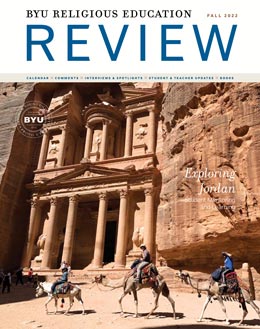The archaeological site of Khirbat ‘Ataruz is located on the ridge of Jabal Hamidah in central Jordan. Situated along ancient trade routes and road systems, the site holds a long-standing place of importance in the ancient history of Jordan. Stories of the past—from the Iron Age, Roman, and Islamic periods—are being revealed at the archaeological excavations at ‘Ataruz.
From a historical perspective, Ataruz is an important site mentioned in the Bible and plays a significant role in the famous Mesha Inscription housed in the Louvre Museum in Paris. According to the inscription, and the general backdrop described in 2 Kings 3, Ataruz dates to the ninth-century-BC wars between the Moabites and the Israelites in the region. At Ataruz a massive Iron Age temple complex, with accompanying destruction layer, provides the framework of the story. Excavations are helping to fill in details of the events and subsequent settlement patterns of this once-developing Moabite dwelling. Excavations in 2022 included work on the stepped-stone sequence ascending the east-west access point to the temple complex on the acropolis, along with the architectural remains of cultic installations with their attendant vessels, pottery, and objects.
For BYU students Jacob Bellows, Emily Buss, Cory Clay, Emily Mehr, Chris Miner, Warren Park, Brandon Pritchard, and Mary Proteau, the summer included an archaeological, cultural, and religious experience in Jordan focused on mentoring and learning.
Before departure, BYU students participated in a preparation course that taught them basic skills and cultural and historical information, as well as archaeological principles and methodologies that would be applied in the field. On arrival, students worked with excavation director Dr. Chang-ho Ji of La Sierra University, Dr. Aaron Schade of BYU’s Department of Ancient Scripture, and Dr. Choong Ryeol, Lee of Sahmyook University. Also joining the excavation was Dr. John McBride of BYU’s Department of Geological Sciences, who conducted ground penetrating radar work at the site.
The mentored student opportunity was set up through BYU’s Kennedy Center as an international study program, with generous support from the Department of Ancient Scripture, the Ancient Near Eastern Studies program, and BYU experiential learning funds. Students interacted closely with faculty as they learned and implemented archaeological methodologies of excavation. With the students’ willingness to learn, hard work, and infectious positive attitudes, 2022 fieldwork was a huge success, helping to answer several questions set out in the objectives of the excavation campaign.
A significant component of the mentoring and learning experience was the opportunities for the students to engage in hands-on work in the field with daily application, discussions, and mentoring. This included implementing archaeological methodologies of excavation and the meticulous recording of data in the form of locus sheets and photographic progress and locus shots.
Additionally, student mentoring and learning included the capturing of 3D scans and images of artifacts from the Madaba Archaeological Museum that included objects, decorated pottery, figurines, statues, and inscriptions discovered at Ataruz.
Some students will also be trained in processing and generating the 3D models of excavated squares, objects, and artifacts. Others will learn photogrammetry, and efforts are being pursued for expanding and achieving a greater global outreach for the site and those interested in doing research on Ataruz and these artifacts. BYU student mentoring and learning helped achieve these arduous objectives and activities. From a mentoring perspective, our pedagogical goals were meant to produce skills, increase qualifications, and provide an academic training that would enhance and bolster our students’ success in their future academic and professional goals.
Students are also helping faculty better implement technological innovations in efforts of streamlining and presenting archaeological data in the form of modern advancements in tools as simple as a cell phone and 3D apps now available to everyone.
A highlight of student learning was the opportunity of regular engagement with local Jordanians. Working alongside the humble and beautiful people of the Beni Hamida tribe, students created friendships that are meaningful, deep, and lasting, all while developing an appreciation and love for the wonderful people of Jordan and their love of God as Muslims and Christians within a diverse community. Many meals and activities witnessed conversations on topics spanning faith, history, and archaeology amid a multicultural and interfaith environment.
Throughout the excavation, students and faculty were able to visit relevant historical and religious sites and discuss important events that ensued there. Locations included Mount Nebo (with its numerous ties to the Exodus, Moses, and the content of books such as Deuteronomy, Joshua, and Judges), Machaerus (traditional site, according to the ancient historian Josephus, where Salome danced before Herod Antipas and John the Baptist was beheaded), Bethany (traditional site on the Jordan River where Jesus was said to have been baptized), Greek Orthodox and Franciscan churches (such as those dedicated to the memory of John the Baptist and the famous St. George Church, which contains a mosaic map of the Holy Land from the sixth century AD), and, of course, Petra and other archaeological sites. These field trips became places of learning, inquiry, discussion, and at times they became spiritual pilgrimages for the students with many testimony-strengthening moments.
In sum, the student mentoring and learning process achieved at Ataruz provided an environment of intellectual and spiritual growth that enabled students and faculty to work together in an atmosphere of discovery. The experience facilitated learning in various spheres, ranging from archaeology and history to language, culture, and religions, all in a multicultural environment. As friendships were forged and new knowledge and skills acquired, students and faculty returned home having been enriched with a diversity of experience that will last and be cherished for a lifetime.
